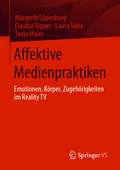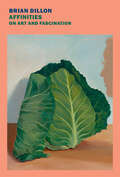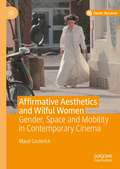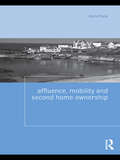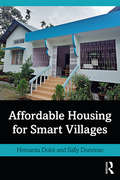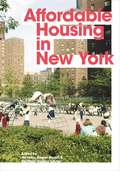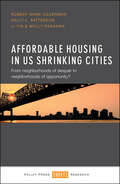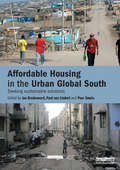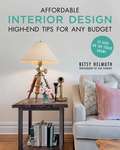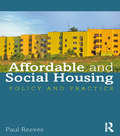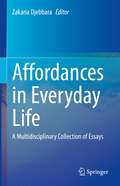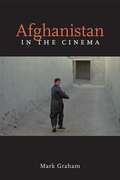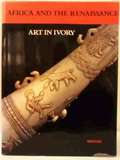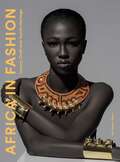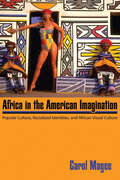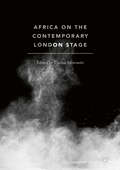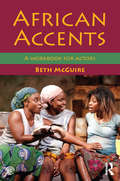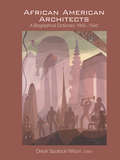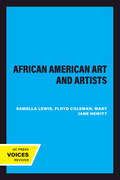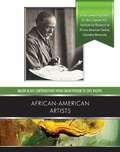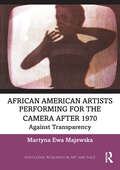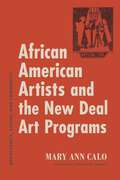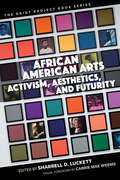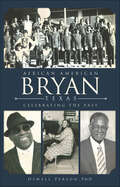- Table View
- List View
Affektive Medienpraktiken: Emotionen, Körper, Zugehörigkeiten im Reality TV
by Margreth Lünenborg Claudia Töpper Laura Sūna Tanja MaierDas Buch liefert eine affekttheoretisch informierte Analyse des Reality TV. Dabei wird das komplexe Affektgeschehen zwischen Fernsehsendung, Medientechnologie und den Körpern der Zuschauenden empirisch zugänglich und sichtbar. Eine multiperspektivische Analyse zeigt auf, welche Strategien und Muster der Erzeugung von Affekten und Emotionen Fernsehproduzent*innen nutzen, wie Inklusion und Exklusion im audiovisuellen Medientext für Zuschauende körperlich spürbar wird und welche Spuren Affekte in den Körpern und den Diskursen des Publikums hinterlassen. Auf den Ebenen Körper, Diskurse und Praktiken werden auf diese Weise affektive Dynamiken der Aushandlung von Zugehörigkeiten analysiert. Die Studie leistet damit einen methodisch wie auch theoretisch innovativen Beitrag zur Affekt- und Emotionsforschung in der Kommunikationswissenschaft.
Affinities: On Art and Fascination
by Brian DillonA meditation on the power and pleasures of the image, from paintings to photographs to migraine auras, by one of Britain's finest literary minds.In Affinities, Brian Dillon, who Joyce Carol Oates has said writes &“fascinating prose . . . on virtually any subject,&” explores images and artists he is drawn to and analyzes the attraction. What does it mean to claim affinity with a picture? What do feelings of affinity imply about the experience of art and of the world? Affinities is a critical and personal study of a sensation that is not exactly taste, desire, or solidarity, but has aspects of all three. Approaching this subject via discrete examples, Dillon examines works by artists such as Dora Maar and Andy Warhol, Rinko Kawauchi and Susan Hiller, as well as scientific or vernacular images of sea creatures and migraine auras. Written as a series of linked essays, Affinities completes a trilogy, with Essayism and Suppose a Sentence, about the intimate and abstract pleasures of reading and looking.
Affirmative Aesthetics and Wilful Women: Gender, Space and Mobility in Contemporary Cinema
by Maud CeuterickFifty years of feminist thought have made the idea that women stay at home while men dominate the streets seem outdated; nevertheless, Ceuterick argues that theoretical considerations of gender, space, and power in film theory remain limited by binary models. Looking instead to more fluid models of spatial relations inspired by Sara Ahmed, Rosi Braidotti, and Doreen Massey, this book discovers wilful, affirmative, and imaginative activations of gender on screen. Through close, micro-analysis of historic European Messidor (Alain Tanner, 1979) and contemporary world cinema: Vendredi Soir (Claire Denis, 2002), Wadjda (Haifaa Al-Mansour, 2012), and Head-On (Fatih Akin, 2004), this book identifies affirmative aesthetics: light, texture, rhythm, movement and sound, all of which that participate in a rewriting of bodies and spaces. Ultimately, Ceuterick argues, affirmative aesthetics can challenge the gender categories and power structures that have been thought to determine our habitation of cars, homes, and city streets. Wilful women drive this book forward, through their movement and stillness, imagination and desire, performance and abjection.
Affluence, Mobility and Second Home Ownership (Housing and Society Series)
by Chris ParisDespite the current recession, the frequency of second home ownership is still surprisingly high throughout the western world. While the UK and Ireland previously had lower occurrences of multiple dwellings compared to the rest of Europe, they are quickly catching up with a current surge in the ownership of second homes. The recent MP expenses scandal in the UK has also drawn attention to the prevalence of second homes (or more) within the middle classes, and the fact that the concept is becoming increasingly popular. Chris Paris uses this text to address the reasons behind why second homes are becoming more popular, both within the usual domicile of the individuals, and in international locations. The socioeconomic factors and historical contexts of homes in cultures across the world are fundamental to explaining the choices in transnational home ownership, and Paris’ case studies and comparisons between additional homes in Europe, Australia, America and Asia expand upon the motivation for people to own a second home. Affluence, Mobility and Second Home Ownership draws together debates on gentrification, globalisation, consumerism, environmental factors and investment to provide a balanced look at the pros, and cons, of second home ownership, and what implications it has for the future. An ideal text for students studying geography, urbanism and planning, this book is also of interest to individuals interested in the changing ways in which we make choices on our places of residence.
Affordable Housing for Smart Villages
by Sally Donovan Hemanta DoloiThis book initiates a fresh discussion of affordability in rural housing set in the context of the rapidly shifting balance between rural and urban populations. It conceptualises affordability in rural housing along a spectrum that is interlaced with cultural and social values integral to rural livelihoods at both personal and community level. Developed around four intersecting themes: explaining houses and housing in rural settings; exploring affordability in the context of aspirations and vulnerability; rural development agendas involving housing and communities; and construction for resilience in rural communities, the book provides an overview of some of the little understood and sometimes counter-intuitive best practices on rural affordability and affordable housing that have emerged in developing economies over the last thirty years. Drawing on practice-based evidence this book presents innovative ideas for harnessing rural potential, and empowering rural communities with added affordability and progressive development in the context of housing and improved living standards. For a student aspiring to work in rural areas in developing countries it is an introduction to and map of some key solutions around the critical area of affordable housing For the rural development professional, it provides a map of a territory they rarely see because they are absorbed in a particular rural area or project For the academic looking to expand their activities into rural areas, especially in rural housing, it provides a handy introduction to a body of knowledge serving 47% of the world's population, and how this differs from urban practice For the policy makers, it provides a map for understanding the dynamics around rural affordability, growth potential and community aspirations helping them to devise appropriate intervention programs on rural housing and development
Affordable Housing in New York: The People, Places, and Policies That Transformed a City
by Nicholas Dagen Bloom Matthew Gordon LasnerA richly illustrated history of below-market housing in New York, from the 1920s to todayA colorful portrait of the people, places, and policies that have helped make New York City livable, Affordable Housing in New York is a comprehensive, authoritative, and richly illustrated history of the city's public and middle-income housing from the 1920s to today. Plans, models, archival photos, and newly commissioned portraits of buildings and tenants by sociologist and photographer David Schalliol put the efforts of the past century into context, and the book also looks ahead to future prospects for below-market subsidized housing. A dynamic account of an evolving city, Affordable Housing in New York is essential reading for understanding and advancing debates about how to enable future generations to call New York home.
Affordable Housing in US Shrinking Cities: From Neighborhoods of Despair to Neighborhoods of Opportunity?
by Robert Mark Silverman Kelly L. PattersonGiven the rapid urbanisation of the world’s population, the converse phenomenon of shrinking cities is often overlooked and little understood. Yet with almost one in ten post-industrial US cities shrinking in recent years, efforts by government and anchor institutions to regenerate these cities is gaining policy urgency, with the availability and siting of affordable housing being a key concern. This is the first book to look at the reasons for the failure (and success) of affordable housing experiences in the fastest shrinking cities in the US. Applying quantitative and GIS analysis using data from the US Department of Housing and Urban Development, the authors make recommendations for future place-based siting practices, stressing its importance for ensuring more equitable urban revitalisation. The book will be a valuable resource for academic researchers and students in urban studies, housing and inequality, as well as policy makers.
Affordable Housing in the Urban Global South: Seeking Sustainable Solutions
by Peer Smets Jan Bredenoord Paul Van LindertThe global increase in the number of slums calls for policies which improve the conditions of the urban poor, sustainably. This volume provides an extensive overview of current housing policies in Asia, Africa and Latin America and presents the facts and trends of recent housing policies. The chapters provide ideas and tools for pro-poor interventions with respect to the provision of land for housing, building materials, labour, participation and finance. The book looks at the role of the various stakeholders involved in such interventions, including national and local governments, private sector organisations, NGOs and Community-based Organisations.
Affordable Interior Design: High-End Tips for Any Budget
by Betsy Helmuth Dov PlawskyLive in luxury—on a budget. Homeowners and renters of all means dream of having a beautiful home. The media makes it look so easy, but many of us have less to work with and still long to live in style. Affordable Interior Design makes luxury an affordable reality. In this DIY home decorating handbook, Helmuth reveals insider tips and her tried-and-tested methods for choosing colors, creating a gallery wall, how to use accent tables, entry benches, rugs, and more! Helmuth has shared her affordable design advice and step-by-step approaches with millions through live teaching workshops, guest columns, television appearances, and interviews. Now, she has distilled her expertise into this practical guide. The chapters follow her secret design formula and include creating a design budget, mapping out floor plans, selecting a color palette, and accessorizing like a stylist. It’s time to start living in the home of your dreams without maxing out your credit cards. Learn how with Affordable Interior Design!
Affordable and Social Housing: Policy and Practice
by Paul ReevesAffordable and Social Housing - Policy and Practice is a candid and critical appraisal of current big-ticket issues affecting the planning, development and management of affordable and social housing in the United Kingdom. The successor to the second edition of the established textbook An Introduction to Social Housing, the book includes new chapters, reflecting the focal importance of customer involvement and empowerment, regeneration and the Localism agenda which will have radical impacts on housing provision and tenure, as well as the town and country planning system which enables its development. There is also a new chapter on Housing Law in response to demand for a clear and signposting exposition of this often complex area. Reeves indicates how each theme affects the other, and suggests policy directions on the basis of past successes and failures. Paul Reeves takes a people-centred approach to the subject, describing the themes that have run through provision of social housing from the first philanthropic industrialists in the 19th Century though to the increasingly complex mixture of ownerships and tenures in the present day. The book is ideal for students of housing and social policy, and for housing professionals aiming to obtain qualifications and wanting a broad understanding of the social housing sector.
Affordances in Everyday Life: A Multidisciplinary Collection of Essays
by Zakaria DjebbaraThe concept of affordances is being increasingly used in fields beyond ecological psychology to reveal previously unexplored interdisciplinary relationships. These fields include engineering, robotics, artificial intelligence, neuroscience, urban theory, architecture, computer science, and much more. As the concept is adapted for its relational meaning between an agent and the environment, or object, the meaning of the term has changed to fit the customs of the adapting field. This book maps the different shades of the term and brings insights into how it is operationalized by providing short accessible essays regardless of background. Each contribution addresses big questions around this topic such as the application of the concept on ongoing research, how to measure or identify affordances, as well as other reflective questions about the future of affordances in the field. The book is envisioned to be read by non-experts, students, and researchers from several disciplines, and fills the need for summarization across disciplines. As the many adaptations flourished from the same psychological concept, this book also aims to function as a catalyst and motivation for reinterpreting the concepts for new directions. Compared to existing books, this book aims not to span the vertical dimension of field by taking a deep dive into a niche-field—instead, this book aims to have a wide horizontal span highlighting a common concept shared by an increasing number of fields, namely affordances. As such, this book takes a different approach by attempting to summarize the different emerging applications and definitions of the concept, and make them accessible to non-experts, students, and researchers regardless of background and level.
Afghanistan in the Cinema
by Mark GrahamIn this timely critical introduction to the representation of Afghanistan in film, Mark Graham examines the often surprising combination of propaganda and poetry in films made in Hollywood and the East. Through the lenses of postcolonial theory and historical reassessment, Graham analyzes what these films say about Afghanistan, Islam, and the West and argues that they are integral tools for forming discourse on Afghanistan, a means for understanding and avoiding past mistakes, and symbols of the country's shaky but promising future. Thoughtfully addressing many of the misperceptions about Afghanistan perpetuated in the West, Afghanistan in the Cinema incorporates incisive analysis of the market factors, funding sources, and political agendas that have shaped the films. The book considers a range of films, beginning with the 1970s epics The Man Who Would Become King and The Horsemen and following the shifts in representation of the Muslim world during the Russian War in films such as The Beast and Rambo III. Graham then moves on to Taliban-era films such as Kandahar, Osama, and Ellipsis, the first Afghan film directed by a woman. Lastly, the book discusses imperialist nostalgia in films such as Charlie Wilson's War and destabilizing visions represented in contemporary works such as The Kite Runner.
Africa and the Renaissance: Art in Ivory
by Ezio Bassani William B. FaggThe first objects from Black Africa to reach European collections were ivories brought from West Africa to Portugal in the last years of the fifteenth century. Records of import duties paid at Lisbon for the year 1504-05
Africa in Fashion: Luxury, Craft and Textile Heritage
by Ken Kweku NimoAfrica in Fashion explores the kaleidoscope of craft cultures that have shaped African fashion for centuries and captures the intriguing stories of contemporary and avant-garde African brands.Part One looks at Africa's rich cultural heritage and place in the network of global fashion. The first chapter retells the history of African fashion, exploring Africa's textile traditions, artisanship and role as a global resource. The second chapter presents a New Africa and examines the promise and potential of Africa's markets, while challenging stereotypes and the concept of European hegemony particularly in the realm of luxury fashion. It also spotlights Africa's unique position as the global industry shifts towards a more sustainable future. Part Two ushers the reader into the spectacular world of African fashion today. It showcases a carefully curated set of the continent's most dynamic brands and, through interviews with prominent and inspiring designers, offers rare insight into their ethos and design practice. Covering unisex fashion, menswear, womenswear, accessories and jewellery the brands are each purposefully selected to contribute uniquely to the mosaic of Africa evolving creative landscape.
Africa in Fashion: Luxury, Craft and Textile Heritage
by Ken Kweku NimoAfrica in Fashion explores the kaleidoscope of craft cultures that have shaped African fashion for centuries and captures the intriguing stories of contemporary and avant-garde African brands.Part One looks at Africa's rich cultural heritage and place in the network of global fashion. The first chapter retells the history of African fashion, exploring Africa's textile traditions, artisanship and role as a global resource. The second chapter presents a New Africa and examines the promise and potential of Africa's markets, while challenging stereotypes and the concept of European hegemony particularly in the realm of luxury fashion. It also spotlights Africa's unique position as the global industry shifts towards a more sustainable future. Part Two ushers the reader into the spectacular world of African fashion today. It showcases a carefully curated set of the continent's most dynamic brands and, through interviews with prominent and inspiring designers, offers rare insight into their ethos and design practice. Covering unisex fashion, menswear, womenswear, accessories and jewellery the brands are each purposefully selected to contribute uniquely to the mosaic of Africa evolving creative landscape.
Africa in the American Imagination: Popular Culture, Racialized Identities, and African Visual Culture
by Carol MageeIn the American world, the presence of African culture is sometimes fully embodied and sometimes leaves only a trace. Africa in the American Imagination: Popular Culture, Racialized Identities, and African Visual Culture explores this presence, examining Mattel's world of Barbie, the 1996 Sports Illustrated swimsuit issue, and Disney World, each of which repackages African visual culture for consumers. Because these cultural icons permeate American life, they represent the broader U.S. culture and its relationship to African culture. This study integrates approaches from art history and visual culture studies with those from culture, race, and popular culture studies to analyze this interchange. Two major threads weave throughout. One analyzes how the presentation of African visual culture in these popular culture forms conceptualizes Africa for the American public. The other investigates the way the uses of African visual culture focuses America's own self-awareness, particularly around black and white racialized identities. In exploring the multiple meanings that “Africa” has in American popular culture, Africa in the American Imagination argues that these cultural products embody multiple perspectives and speak to various sociopolitical contexts: the Cold War, civil rights, and contemporary eras of the United States; the apartheid and post-apartheid eras of South Africa; the colonial and postcolonial eras of Ghana; and the European era of African colonization.
Africa on the Contemporary London Stage
by Tiziana MorosettiThis collection of essays investigates the way Africa has been portrayed on the London stage from the 1950s to the present. It focuses on whether — and, if so, to what extent — the Africa that emerges from the London scene is subject to stereotype, and/or in which ways the reception of audiences and critics have contributed to an understanding of the continent and its arts. The collection, divided into two parts, brings together well-established academics and emerging scholars, as well as playwrights, directors and performers currently active in London. With a focus on Wole Soyinka, Athol Fugard, Bola Agbaje, Biyi Bandele, and Dipo Agboluaje, amongst others, the volume examines the work of key companies such as Tiata Fahodzi and Talawa, as well as newer companies Two Gents, Iroko Theatre and Spora Stories. Interviews with Rotimi Babatunde, Ade Solanke and Dipo Agboluaje on the contemporary London scene are also included.
African Accents: A Workbook for Actors
by Beth McGuireThis is a comprehensive workbook for actors, covering the key characteristics and profiles of a wide range of African accents of English. Its unique approach not only addresses the methods and processes by which to go about learning an accent, but also looks in detail at each example. This lets the reader plot their own route through the learning process and tailor not only their working methods but also their own personal idiolect. Full breakdowns of each accent cover: an introduction giving a brief history of the accent, its ethnic background, and its language of origin preparatory warm-up exercises specific to each accent a directory of research materials including documentaries, plays, films and online resources key characteristics such as melody, stress, pace and pitch descriptions of physical articulation in the tongue, lips, jaw, palate and pharynx practice sentences, phoneme tables and worksheets for solo study. African Accents is accompanied by a website at www.routledge.com/cw/mcguire with an extensive online database of audio samples for each accent. The book and audio resources guide actors to develop their own authentic accents, rather than simply to mimic native speakers. This process allows the actor to personalize an accent, and to integrate it into the creation of character rather than to play the accent on top of character.
African American Architects: A Biographical Dictionary, 1865-1945
by Dreck Spurlock WilsonAfrican-American architects have been designing and building houses and public buildings since 1865. Although many of these structures survive today, the architects themselves are virtually unknown. This unique reference work brings their lives and work to light for the first time. Written by 100 experts ranging from architectural historians to archivists, this book contains 160 biographical, A-Z entries on African-American architects from the era of Emancipation to the end of World War II. Articles provide biographical facts about each architect, and commentary on his or her work. Practical and accessible, this reference is complemented by over 200 photographs and includes an appendix containing a list of buildings by geographic location and by architect.
African American Art and Artists
by Samella LewisSamella Lewis has brought African American Art and Artists fully up to date in this revised and expanded edition. The book now looks at the works and lives of artists from the eighteenth century to the present, including new work in traditional media as well as in installation art, mixed media, and digital/computer art. Mary Jane Hewitt, an author, curator, and longtime friend of Samella Lewis's, has written an introduction to the new edition. Generously and handsomely illustrated, the book continues to reveal the rich legacy of work by African American artists, whose art is now included in the permanent collections of national and international museums as well as in major private collections.
African American Artists (Major Black Contributions from Emancipat)
by Carol EllisFrom quilts to marble, from comic strips to welded steel, African Americans have created exciting works of art for more than a hundred years. African-American Artists traces the struggles and shows the work of many of these men and women. This book will introduce you to Harriet Powers, who was born a slave and who told legends and stories on her quilts. You'll meet Horace Pippin, who taught himself to paint and kept painting even after he lost the use of his arm. Cartoonist Aaron McGruder and digital artist Angela Perkins are among the African-American artists who continue to enrich the nation's culture today.
African American Artists Performing for the Camera After 1970: Against Transparency (Routledge Research in Art and Race)
by Martyna Ewa MajewskaThis study demonstrates how African American artists active since the 1970s have instrumentalized performance for the camera to intervene in existing representations of Black and Brown people in America and beyond.Majewska argues that producing carefully designed photographs, films, and videos via performance became a key strategy for dismantling the conceptions of race and gender fixed by US popular culture, jurisprudence, and pseudoscience. Studying the work of Adrian Piper, Glenn Ligon, Lyle Ashton Harris, Senga Nengudi, Maren Hassinger, Howardena Pindell, David Hammons, and Pope.L, this book examines the ways in which these artists incorporate their bodies and personal experience into their respective performances, simultaneously courting and foreclosing autobiographical readings. The strategies examined here, while diverse, all challenge conventional interpretations of performance art—especially those overdetermined by race, gender, and sexuality.The book will be of interest to scholars working in art history, performance studies, photography, and African American studies.
African American Artists and the New Deal Art Programs: Opportunity, Access, and Community
by Mary Ann CaloThis book examines the involvement of African American artists in the New Deal art programs of the 1930s. Emphasizing broader issues informed by the uniqueness of Black experience rather than individual artists’ works, Mary Ann Calo makes the case that the revolutionary vision of these federal art projects is best understood in the context of access to opportunity, mediated by the reality of racial segregation.Focusing primarily on the Federal Art Project (FAP) of the Works Progress Administration (WPA), Calo documents African American artists’ participation in community art centers in Harlem, in St. Louis, and throughout the South. She examines the internal workings of the Harlem Artists’ Guild, the Guild’s activities during the 1930s, and its alliances with other groups, such as the Artists’ Union and the National Negro Congress. Calo also explores African American artists’ representation in the exhibitions sponsored by WPA administrators and the critical reception of their work. In doing so, she elucidates the evolving meanings of the terms race, culture, and community in the interwar era. The book concludes with an essay by Jacqueline Francis on Black artists in the early 1940s, after the end of the FAP program.Presenting essential new archival information and important insights into the experiences of Black New Deal artists, this study expands the factual record and positions the cumulative evidence within the landscape of critical race studies. It will be welcomed by art historians and American studies scholars specializing in early twentieth-century race relations.
African American Arts: Activism, Aesthetics, and Futurity (The Griot Project Book Series)
by Sharrell D. Luckett Carmen Gillespie Rikki Byrd Amber Lauren Johnson Doria E. Charlson Florencia V. Cornet Daniel McNeil Lucy Caplan Genevieve Hyacinthe Sammantha McCalla Nettrice R. Gaskins Abby Dobson J. Michael Kinsey Shondrika Moss-Bouldin Julie B. Johnson Jasmine Eileen Coles Tawnya Pettiford-Wates Rickerby HindsSignaling such recent activist and aesthetic concepts in the work of Kara Walker, Childish Gambino, BLM, Janelle Monáe, and Kendrick Lamar, and marking the exit of the Obama Administration and the opening of the National Museum of African American History and Culture, this anthology explores the role of African American arts in shaping the future, and further informing new directions we might take in honoring and protecting the success of African Americans in the U.S. The essays in African American Arts: Activism, Aesthetics, and Futurity engage readers in critical conversations by activists, scholars, and artists reflecting on national and transnational legacies of African American activism as an element of artistic practice, particularly as they concern artistic expression and race relations, and the intersections of creative processes with economic, sociological, and psychological inequalities. Scholars from the fields of communication, theater, queer studies, media studies, performance studies, dance, visual arts, and fashion design, to name a few, collectively ask: What are the connections between African American arts, the work of social justice, and creative processes? If we conceive the arts as critical to the legacy of Black activism in the United States, how can we use that construct to inform our understanding of the complicated intersections of African American activism and aesthetics? How might we as scholars and creative thinkers further employ the arts to envision and shape a verdant society? Contributors: Carrie Mae Weems, Carmen Gillespie, Rikki Byrd, Amber Lauren Johnson, Doria E. Charlson, Florencia V. Cornet, Daniel McNeil, Lucy Caplan, Genevieve Hyacinthe, Sammantha McCalla, Nettrice R. Gaskins, Abby Dobson, J. Michael Kinsey, Shondrika Moss-Bouldin, Julie B. Johnson, Sharrell D. Luckett, Jasmine Eileen Coles, Tawnya Pettiford-Wates, Rickerby Hinds. Published by Bucknell University Press. Distributed worldwide by Rutgers University Press.
African American Bryan, Texas: Celebrating the Past (American Heritage)
by Oswell Person PhDBryan was incorporated in 1872, but it would take more than ten years before its African American population was offered schooling. Nothing would come easy for them, but they persevered through hard work, ingenuity and family support. The success of today's generation is a direct result of determined, hardworking pioneers like Dr. Samuel J. Sealey Sr., Bryan's "baby doctor" in the 1930s and '40s, and Dr. William A. Hammond Sr., who opened Bryan's first black hospital and employed many blacks through his business ventures. Learn about the inspiration and guidance provided by the likes of Oliver Wayne Sadberry, an outstanding community leader and principal of Fairview and Washington Elementary. Dr. Oswell Person shares the story of this community's achievements, successes and contributions in the face of incredible odds.
